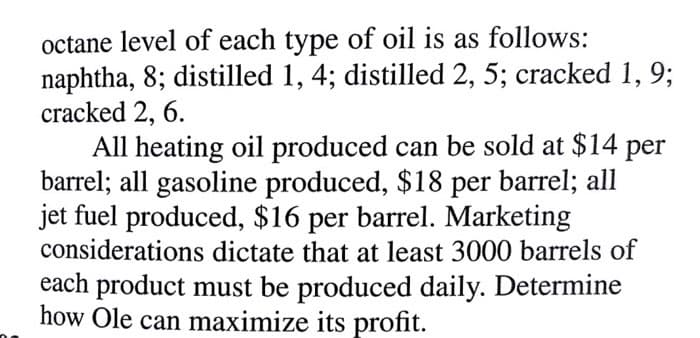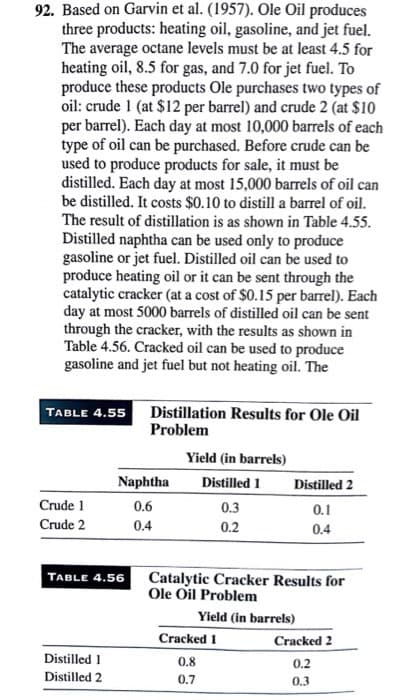92. Based on Garvin et al. (1957). Ole Oil produces three products: heating oil, gasoline, and jet fuel. The average octane levels must be at least 4.5 for heating oil, 8.5 for gas, and 7.0 for jet fuel. To produce these products Ole purchases two types of oil: crude 1 (at $12 per barrel) and crude 2 (at $10 per barrel). Each day at most 10,000 barrels of each type of oil can be purchased. Before crude can be used to produce products for sale, it must be distilled. Each day at most 15,000 barrels of oil can be distilled. It costs $0.10 to distill a barrel of oil. The result of distillation is as shown in Table 4.55. Distilled naphtha can be used only to produce gasoline or jet fuel. Distilled oil can be used to produce heating oil or it can be sent through the catalytic cracker (at a cost of $0.15 per barrel). Each day at most 5000 barrels of distilled oil can be sent through the cracker, with the results as shown in Table 4.56. Cracked oil can be used to produce gasoline and jet fuel but not heating oil. The TABLE 4.55 Distillation Results for Ole Oil Problem Yield (in barrels) Naphtha Distilled 1 Distilled 2 Crude 1 0.6 0.3 0.1 Crude 2 0.4 0.2 0.4 Catalytic Cracker Results for Ole Oil Problem Yield (in barrels) TABLE 4.56 Cracked I Cracked 2 Distilled I 0.8 0.2 Distilled 2 0.7 0.3
92. Based on Garvin et al. (1957). Ole Oil produces three products: heating oil, gasoline, and jet fuel. The average octane levels must be at least 4.5 for heating oil, 8.5 for gas, and 7.0 for jet fuel. To produce these products Ole purchases two types of oil: crude 1 (at $12 per barrel) and crude 2 (at $10 per barrel). Each day at most 10,000 barrels of each type of oil can be purchased. Before crude can be used to produce products for sale, it must be distilled. Each day at most 15,000 barrels of oil can be distilled. It costs $0.10 to distill a barrel of oil. The result of distillation is as shown in Table 4.55. Distilled naphtha can be used only to produce gasoline or jet fuel. Distilled oil can be used to produce heating oil or it can be sent through the catalytic cracker (at a cost of $0.15 per barrel). Each day at most 5000 barrels of distilled oil can be sent through the cracker, with the results as shown in Table 4.56. Cracked oil can be used to produce gasoline and jet fuel but not heating oil. The TABLE 4.55 Distillation Results for Ole Oil Problem Yield (in barrels) Naphtha Distilled 1 Distilled 2 Crude 1 0.6 0.3 0.1 Crude 2 0.4 0.2 0.4 Catalytic Cracker Results for Ole Oil Problem Yield (in barrels) TABLE 4.56 Cracked I Cracked 2 Distilled I 0.8 0.2 Distilled 2 0.7 0.3
Principles of Economics 2e
2nd Edition
ISBN:9781947172364
Author:Steven A. Greenlaw; David Shapiro
Publisher:Steven A. Greenlaw; David Shapiro
Chapter13: Positive Externalities And Public Goods
Section: Chapter Questions
Problem 23P: HighFlyer Airlines wants to build new airplanes with greatly increased cabin space. This will allow...
Related questions
Question

Transcribed Image Text:octane level of each type of oil is as follows:
naphtha, 8; distilled 1, 4; distilled 2, 5; cracked 1, 9;
cracked 2, 6.
All heating oil produced can be sold at $14 per
barrel; all gasoline produced, $18 per barrel; all
jet fuel produced, $16 per barrel. Marketing
considerations dictate that at least 3000 barrels of
each product must be produced daily. Determine
how Ole can maximize its profit.

Transcribed Image Text:92. Based on Garvin et al. (1957). Ole Oil produces
three products: heating oil, gasoline, and jet fuel.
The average octane levels must be at least 4.5 for
heating oil, 8.5 for gas, and 7.0 for jet fuel. To
produce these products Ole purchases two types of
oil: crude 1 (at $12 per barrel) and crude 2 (at $10
per barrel). Each day at most 10,000 barrels of each
type of oil can be purchased. Before crude can be
used to produce products for sale, it must be
distilled. Each day at most 15,000 barrels of oil can
be distilled. It costs $0.10 to distill a barrel of oil.
The result of distillation is as shown in Table 4.55.
Distilled naphtha can be used only to produce
gasoline or jet fuel. Distilled oil can be used to
produce heating oil or it can be sent through the
catalytic cracker (at a cost of $0.15 per barrel). Each
day at most 5000 barrels of distilled oil can be sent
through the cracker, with the results as shown in
Table 4.56. Cracked oil can be used to produce
gasoline and jet fuel but not heating oil. The
TABLE 4.55 Distillation Results for Ole Oil
Problem
Yield (in barrels)
Naphtha
Distilled 1
Distilled 2
Crude 1
0.6
0.3
0.1
Crude 2
0.4
0.2
0.4
Catalytic Cracker Results for
Ole Oil Problem
TABLE 4.56
Yield (in barrels)
Cracked 1
Cracked 2
Distilled 1
0.8
0.2
Distilled 2
0.7
0.3
Expert Solution
This question has been solved!
Explore an expertly crafted, step-by-step solution for a thorough understanding of key concepts.
This is a popular solution!
Trending now
This is a popular solution!
Step by step
Solved in 8 steps with 10 images

Recommended textbooks for you

Principles of Economics 2e
Economics
ISBN:
9781947172364
Author:
Steven A. Greenlaw; David Shapiro
Publisher:
OpenStax


Principles of Economics 2e
Economics
ISBN:
9781947172364
Author:
Steven A. Greenlaw; David Shapiro
Publisher:
OpenStax
